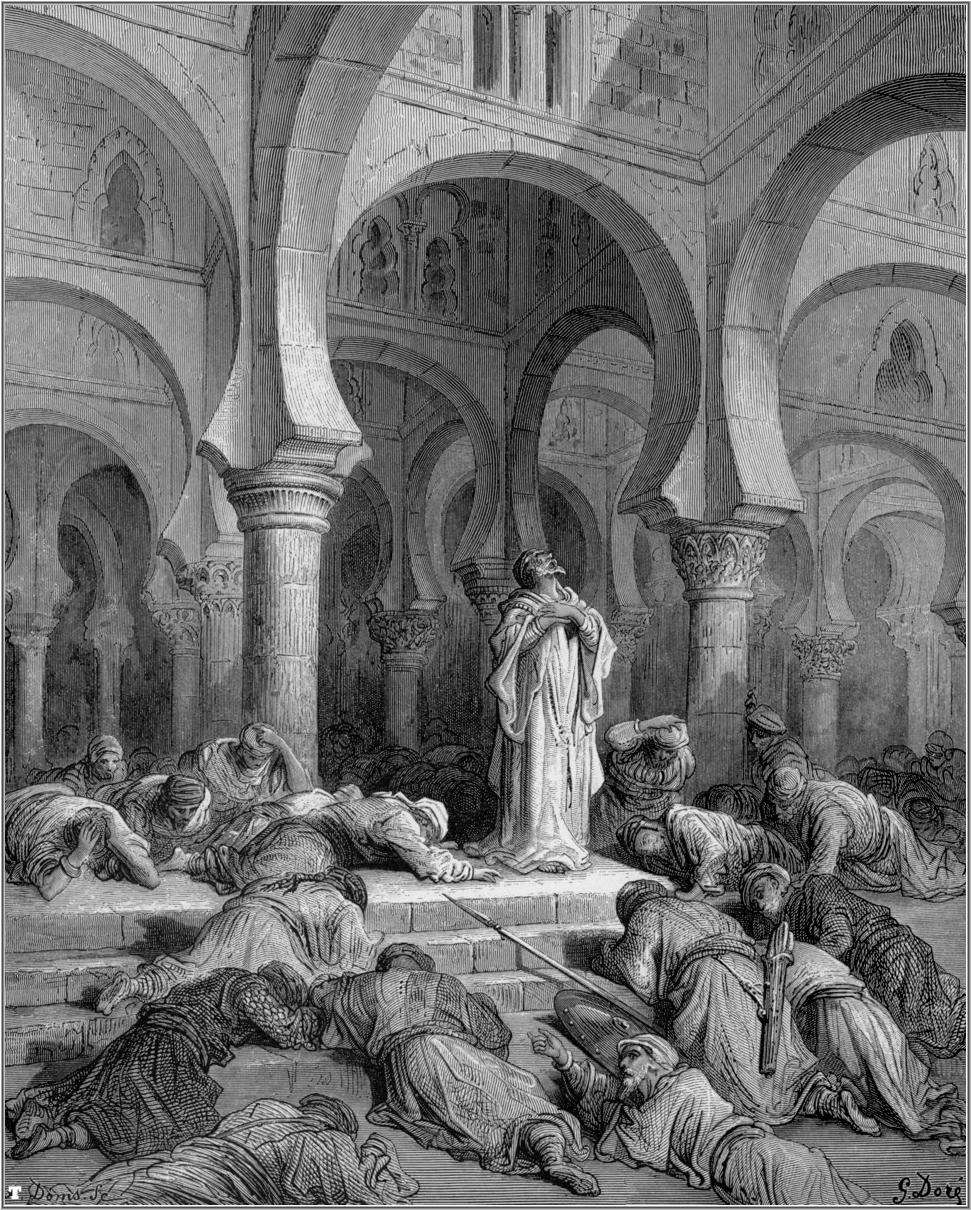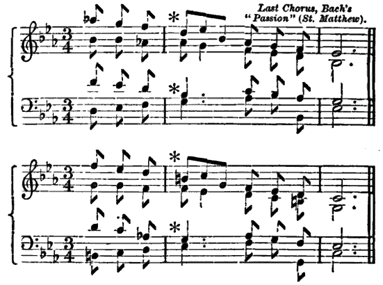|
Symphony No. 8 (Kabeláč)
The 8th Symphony "Antiphonies", Op. 54, by Miloslav Kabeláč was written in 1970 as a reflection of the composer's feelings from the invasion of Warsaw Pact troops into Czechoslovakia in 1968 and the onset of so-called "normalization" process in the society, which means renewal of strong dictate of the regime of pro-Soviet communist rulers, including heavy loss of basic freedoms for citizens of the country. The composition consists of nine parts – five movements and four interludes, structure of which is controlled by a firm logical order, proportionally and symmetry. Its structural and expressive axis is the third – the longest movement. The intermedia linking the individual movements correspond both in time and music and differ only in an alternately opposite dynamic succession. The work is written for a percussion ensemble (6 musicians), the organ, a coloration soprano and two mixed choirs (large and small). The text of the vocal part is taken from the Old Testament. The 8 ... [...More Info...] [...Related Items...] OR: [Wikipedia] [Google] [Baidu] |
Miloslav Kabeláč
Miloslav Kabeláč (1 August 1908 – 17 September 1979) was a distinguished Czech composer and conductor. Kabeláč belongs to the foremost Czech symphonists, whose work is sometimes compared with Antonín Dvořák's and Bohuslav Martinů's. In the communist period, his work was on the periphery of official attention and was performed sporadically and in a limited choice of compositions. Life Kabeláč was born in Prague. In 1928–31 he studied at the Prague Conservatory as a pupil of Karel Boleslav Jirák, simultaneously (in 1930–31) he was a pupil of Alois Hába. In 1932–54 Kabeláč was employed by Prague Radio. From 1957 to 1968 he worked as a teacher at the Prague Conservatory. During his life Kabeláč was active in '' Umělecká beseda'', in the ''Federation of Czechoslovak Composers'' and other organisations. In the 1960s he tried to revive contacts with Western modern music and composers, but after the 1968 Soviet invasion of Czechoslovakia he ... [...More Info...] [...Related Items...] OR: [Wikipedia] [Google] [Baidu] |
Strasbourg
Strasbourg ( , ; ; ) is the Prefectures in France, prefecture and largest city of the Grand Est Regions of France, region of Geography of France, eastern France, in the historic region of Alsace. It is the prefecture of the Bas-Rhin Departments of France, department and the Seat of the European Parliament in Strasbourg, official seat of the European Parliament. The city has about three hundred thousand inhabitants, and together Eurométropole de Strasbourg, Greater Strasbourg and the arrondissement of Strasbourg have over five hundred thousand. Strasbourg's functional area (France), metropolitan area had a population of 860,744 in 2020, making it the eighth-largest metro area in France and home to 14% of the Grand Est region's inhabitants. The transnational Eurodistrict Strasbourg-Ortenau Eurodistrict, Strasbourg-Ortenau had a population of roughly 1,000,000 in 2022. Strasbourg is one of the ''de facto'' four main capitals of the European Union (alongside Brussels, Luxembourg ... [...More Info...] [...Related Items...] OR: [Wikipedia] [Google] [Baidu] |
Panton Records
Panton Records or PANTON was a Czechoslovak and later Czech record label and music publishing house of the Czech Music Fund, founded in 1968. In Czechoslovakia, it was one of the three major state-owned labels, the other two being Supraphon and Opus. Panton specialized primarily in publishing contemporary classical sheet music. The company was active until the mid-1990s, after which its musical catalogue moved to Supraphon. at discogs
Discogs ( ; short for " discographies") is a database of information about audio recordings, including commercial releases, promotional releases, and bootleg or off-label releases. Database contents are user-generated, and described in ''T ...
[...More Info...] [...Related Items...] OR: [Wikipedia] [Google] [Baidu] |
Václav Neumann
Václav Neumann (29 October 1920 – 2 September 1995) was a Czech conductor, violinist, violist, and opera director. Life and career Neumann was born in Prague, where he studied at the Prague Conservatory with Josef Micka (violin), and Pavel Dědeček and Metod Doležil (conducting) from 1940 through 1945. He co-founded the Smetana Quartet, playing 1st violin and then viola. Neumann made his debut as a conductor with the Czech Philharmonic Orchestra in 1948, remaining as a conductor with that ensemble through 1950. In 1951 he became principal conductor of the Karlovy Vary Symphony Orchestra. He left that post in 1954 to become principal conductor of the Brno Symphony Orchestra (SOKB). In 1956, he began to conduct at the Komische Oper in Berlin; beginning with a celebrated production of Janáček’s '' The Cunning Little Vixen'' on 30 May 1956. He toured with that production to Paris and Wiesbaden; conducting a total of 215 performance between the three cities. He r ... [...More Info...] [...Related Items...] OR: [Wikipedia] [Google] [Baidu] |
Czech Philharmonic Choir
Czech may refer to: * Anything from or related to the Czech Republic, a country in Europe ** Czech language ** Czechs, the people of the area ** Czech culture ** Czech cuisine * One of three mythical brothers, Lech, Czech, and Rus *Czech (surname) *Czech, Łódź Voivodeship, Poland *Czechville, Wisconsin, unincorporated community, United States See also * Čech, a surname * Czech lands * Czechoslovakia * List of Czechs * * * Check (other) * Czechoslovak (other) * Czech Republic (other) * Czechia (other) Czechia is the official short form name of the Czech Republic. Czechia may also refer to: * Historical Czech lands *Czechoslovakia (1918–1993) *Czech Socialist Republic (1969–1990) *Protectorate of Bohemia and Moravia (1939–1945) See also ... {{disambiguation Language and nationality disambiguation pages ... [...More Info...] [...Related Items...] OR: [Wikipedia] [Google] [Baidu] |
Czech Philharmonic Orchestra
The Czech Philharmonic () is a symphony orchestra based in Prague. Its principal performing venue is the Rudolfinum concert hall. History The name "Czech Philharmonic Orchestra" appeared for the first time in 1894, as the title of the orchestra of the Prague National Theatre. It played its first concert under its current name on 4 January 1896 when Antonín Dvořák conducted his own compositions, but it did not become fully independent from the opera until 1901. The first representative concert took place on 15 October 1901 conducted by Ludvík Čelanský, the first artistic director of the orchestra. In 1908, Gustav Mahler led the orchestra in the world premiere of his Symphony No. 7. The orchestra first became internationally known during the principal conductorship of Václav Talich, who held the post from 1919 to 1931, and again from 1933 to 1941. In 1941, Talich and the orchestra made a controversial journey to Germany, where they performed Bedřich Smetana's '' M ... [...More Info...] [...Related Items...] OR: [Wikipedia] [Google] [Baidu] |
Invocation
Invocation is the act of calling upon a deity, spirit, or supernatural force, typically through prayer, ritual, or spoken formula, to seek guidance, assistance, or presence. It is a practice found in numerous religious, spiritual, and esoteric traditions, where it serves to establish a connection between the human and the divine or metaphysical realms. Invocation can be directed toward a singular deity, multiple deities, spirits, or abstract forces, and may involve formal liturgies, spontaneous prayers, chants, or symbolic actions. Unlike evocation, which is generally understood as calling a spirit to appear outside the practitioner, invocation often implies inviting the entity to be present within or to closely align with the practitioner. The purpose of invocation varies across cultural and religious contexts. In many traditions, it is used to request divine intervention, protection, wisdom, or blessings in personal or communal matters. Invocation may also serve to con ... [...More Info...] [...Related Items...] OR: [Wikipedia] [Google] [Baidu] |
Rhythm
Rhythm (from Greek , ''rhythmos'', "any regular recurring motion, symmetry") generally means a " movement marked by the regulated succession of strong and weak elements, or of opposite or different conditions". This general meaning of regular recurrence or pattern in time can apply to a wide variety of cyclical natural phenomena having a periodicity or frequency of anything from microseconds to several seconds (as with the riff in a rock music song); to several minutes or hours, or, at the most extreme, even over many years. The Oxford English Dictionary defines rhythm as ''"The measured flow of words or phrases in verse, forming various patterns of sound as determined by the relation of long and short or stressed and unstressed syllables in a metrical foot or line; an instance of this"''. Rhythm is related to and distinguished from pulse, meter, and beats: In the performance arts, rhythm is the timing of events on a human scale; of musical sounds and silences that occur ... [...More Info...] [...Related Items...] OR: [Wikipedia] [Google] [Baidu] |
Pitch (music)
Pitch is a perception, perceptual property that allows sounds to be ordered on a frequency-related scale (music), scale, or more commonly, pitch is the quality that makes it possible to judge sounds as "higher" and "lower" in the sense associated with musical melody, melodies. Pitch is a major auditory system, auditory attribute of musical tones, along with duration (music), duration, loudness, and timbre. Pitch may be quantified as a frequency, but pitch is not a purely objective physical property; it is a subjective Psychoacoustics, psychoacoustical attribute of sound. Historically, the study of pitch and pitch perception has been a central problem in psychoacoustics, and has been instrumental in forming and testing theories of sound representation, processing, and perception in the auditory system. Perception Pitch and frequency Pitch is an auditory sensation in which a listener assigns musical tones to relative positions on a musical scale based primarily on their percep ... [...More Info...] [...Related Items...] OR: [Wikipedia] [Google] [Baidu] |
Modality (music)
In music theory, the term mode or ''modus'' is used in a number of distinct senses, depending on context. Its most common use may be described as a type of musical scale coupled with a set of characteristic melodic and harmonic behaviors. It is applied to major and minor keys as well as the seven diatonic modes (including the former as Ionian and Aeolian) which are defined by their starting note or tonic. (Olivier Messiaen's modes of limited transposition are strictly a scale type.) Related to the diatonic modes are the eight church modes or Gregorian modes, in which authentic and plagal forms of scales are distinguished by ambitus and tenor or reciting tone. Although both diatonic and Gregorian modes borrow terminology from ancient Greece, the Greek ''tonoi'' do not otherwise resemble their medieval/modern counterparts. Previously, in the Middle Ages the term modus was used to describe intervals, individual notes, and rhythms (see ). Modal rhythm was an essential featur ... [...More Info...] [...Related Items...] OR: [Wikipedia] [Google] [Baidu] |
Belshazzar's Feast
Belshazzar's feast, or the story of the writing on the wall, chapter 5 in the Book of Daniel, tells how Neo-Babylonian royal Belshazzar holds a great feast and drinks from the vessels that had been looted in the destruction of the First Temple. A hand appears and writes on the wall. The terrified Belshazzar calls for his wise men, but they cannot read the writing. The queen advises him to send for Daniel, renowned for his wisdom. Daniel reminds Belshazzar that his father, Nebuchadnezzar, when he became arrogant, was thrown down until he learned that God has sovereignty over the kingdom of men (see Daniel 4). Belshazzar had likewise blasphemed God, and so God sent this hand. Daniel then reads the message and interprets it: God has numbered Belshazzar's days, he has been weighed and found wanting, and his kingdom will be given to the Medes and the Persians. The message of Daniel 5 is the contrast it offers between Nebuchadnezzar and Belshazzar: * Nebuchadnezzar is humbled by God ... [...More Info...] [...Related Items...] OR: [Wikipedia] [Google] [Baidu] |






